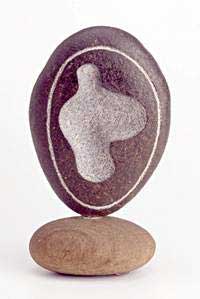Antonio Ballester: Sculptures and drawings
The sculptor Antonio Ballester Vilaseca (Valencia 1910) is the son of Antonio Ballester Aparicio, a sculptor of renowned prestige in the city, who was visited in his studio by artists and intellectuals. Guided by his father from an early age, he learnt drawing and modelling. He also visited the studios of other sculptors, such as Enrique Cuñat, and painters, such as Ricardo Verde, Garnelo, Capuz and Luis Felipe Usábal. In 1922, at the age of 12, he enrolled at the Escuela de Bellas Artes de San Carlos, where he formed friendships with Francisco Carreño and Josep Renau, whose influence can be seen in the mixture of Art Deco and avant-gardism in his work and also in his political commitment. He obtained the highest academic marks and in 1927, by unanimous decision, was awarded the Roig Prize for his final project. Shortly afterwards he began to produce works made with found objects, such as Signo en cantos rodados (Traces on Pebbles), c. 1929, works of extreme purity providing certain echoes of the School of Vallecas and the abstraction of Hans Arp. In the course of his artistic career he has shown his mastery of various different techniques of sculpture, in his wood carvings and his works in moulded clay, bronze or iron. Influenced by Art Deco, he made the plaster maquette of Relieve con figura femenina bebiendo y simio sentado (Relief with a drinking female and a seated monkey), 1928, and Tríptico (Triptych), 1929. In the creation of this latter work his friends Josep Renau and Francisco Badía also participated. His prestige increased when, in 1929, he won the International Competition for the Monument to the Independence of Uruguay, organised by the city of Paysandú (Uruguay), with a forceful sculpture which showed American Indian and Art Deco influences. In 1931, shortly before the proclamation of the Second Republic, he took part in an avant-garde group exhibition in the premises of the Agrupación Valencianista Republicana; many of the artists who participated were to become members of the future UEAP (Union of Proletarian Artists and Writers). In 1933 he obtained a position as a teacher of Drawing at the Instituto Blasco Ibáñez in Valencia. At the start of the Civil War he was one of the first artists to offer his work in defence of the Republican cause and he designed the first posters that were distributed throughout the city in defence of the Government. During the war he was attached to the Propaganda Section of the Delegation of Anti-Fascist Militias. He took part in the activities of the Alliance of Anti-Fascist Intellectuals and contributed to the magazine Nueva Cultura, founded in 1935 by Josep Renau. In the Spanish Republic’s pavilion at the World’s Fair in Paris in 1937 he exhibited the reliefs Fuenteovejuna, 1935, and Los vencedores de Brihuega (The Victors of Brihuega), in polychrome carved wood and coloured cement respectively, works which displayed remarkable sobriety and a realistic treatment of the figures. In 1938 he was posted to the Army Propaganda Section and contributed to the magazine Comisario. He was also one of the illustrators of the book Canciones de lucha, an anthology of war songs compiled by the composer Carlos Palacio. When the war ended he was imprisoned and debarred from resuming his position as a teacher of drawing. He helped to create the Art Workshop which acted as a focus for various artists who were in prison. When he was released he resumed working in his studio, carrying out various commissions for religious images. In 1946 he emigrated to Mexico, where his sisters and his brother-in-law, Josep Renau, had already sought refuge. In Mexico City he joined the circles of the Valencian Republican refugees. The prestige that he achieved with his sculptures of religious images brought him a variety of commissions of work for churches and convents. While living in the Mexican capital he also worked with another Spanish exile, the Alicante architect Félix Candela, on the decoration and ornamentation of the church of Our Lady of the Miraculous Medal, for which he designed practically all the iconographic, ornamental and devotional items. He also made a great many sculptures and drawings, influenced by various different manifestations of modern figurative art in Europe, with a special predilection for the work of Matisse, Henry Moore and Arturo Martini. In 1960 he moved to Los Angeles (California), where, among other sculptural works, he made La Familia (The Family), for the façade of the Home Savings and Loan Association building, and the main altarpiece for the St. John’s Seminary in Camarillo (California). He returned to Spain in 1963 and settled in Valencia, where he continued working on commissions received from California and on more personal work.



